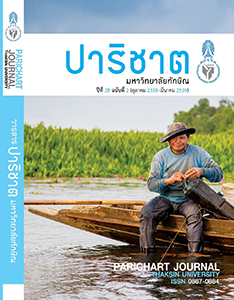The Effects of Cooperative Learning Using Student-Teams-Achievement Division (STAD) Technique on the Undergraduate Students’ Learning Outcome of English Grammar at Thaksin University
Main Article Content
Abstract
การวิจัยนี้มีวัตถุประสงค์เพื่อเปรียบเทียบความ สามารถด้านไวยากรณ์ภาษาอังกฤษ ของนิสิต ก่อนและหลังได้รับการสอนโดยใช้เทคนิคการแบ่งกลุ่มผลสัมฤทธิ์และเพื่อศึกษา ทัศนคติของนิสิตที่มีต่อเทคนิคการแบ่งกลุ่มผลสัมฤทธิ์ กลุ่มตัวอย่าง คือ นิสิตระดับปริญญาตรี จำนวน 26 คน ที่ลงทะเบียนเรียน วิชาภาษาอังกฤษทั่วไป 3 ในภาคเรียนที่ 2 ปกี ารศึกษา 2556 เครื่องมือที่ใช้ คือ แบบทดสอบไวยากรณ์ แบบทดสอบย่อยและแบบสอบถาม เก็บข้อมูล จากแบบทดสอบไวยากรณ์ แบบทดสอบย่อยและแบบสอบถาม ข้อมูลเชิงปริมาณวิเคราะห์ และนำเสนอโดยใช้ค่าร้อยละและค่าเฉลี่ย เปรียบเทียบค่าเฉลี่ยคะแนนของนิสิตก่อนและ หลังโดยใช้ t-test ส่วนข้อมูลเชิงคุณภาพวิเคราะห์นำข้อมูลมาจัดกลุ่มแล้วรายงานผล ในลักษณะเชิงบรรยาย ผลการวิจัยพบว่า ความสามารถด้านไวยากรณ์ภาษาอังกฤษของนิสิต ระดับปริญญาตรีที่เรียนแบบร่วมมือโดยใช้เทคนิคการแบ่งกลุ่มผลสัมฤทธิ์หลังเรียนมีความ แตกต่างอย่างมีนัยสำคัญ ทางสถิติที่ระดับ 0.01 และทัศนคติของนิสิตที่มีต่อเทคนิคการสอน แบบการสอนโดยใช้เทคนิคการแบ่งกลุ่มผลสัมฤทธิ์ ชี้ให้เห็นว่ามีทัศนคติทางบวก
The Effects of Cooperative Learning Using Student-Teams-Achievement Division (STAD) Technique on the Undergraduate Students’ Learning Outcome of English Grammar at Thaksin University
Jureeporn Malelohit
The aims of the study were (1) to compare the students’ English grammar ability before and after being taught with using STAD technique and (2) to study their attitudes towards to the use of STAD technique. The samples were 26 undergraduate students who registered General English 3, in the 2nd semester of the 2013 academic year. The instruments were grammar tests, quizzes, questionnaire. Data were collected from grammar tests, quizzes and questionnaire. The quantitative data were analyzed and presented in the percentage and means. The qualitative data were grouped and concluded in the form of a descriptive report. The results found that the students’ English grammar ability after being taught with STAD was significantly different at the 0.01 level. And the subjects’ attitudes towards to the use of STAD technique indicated positive.


